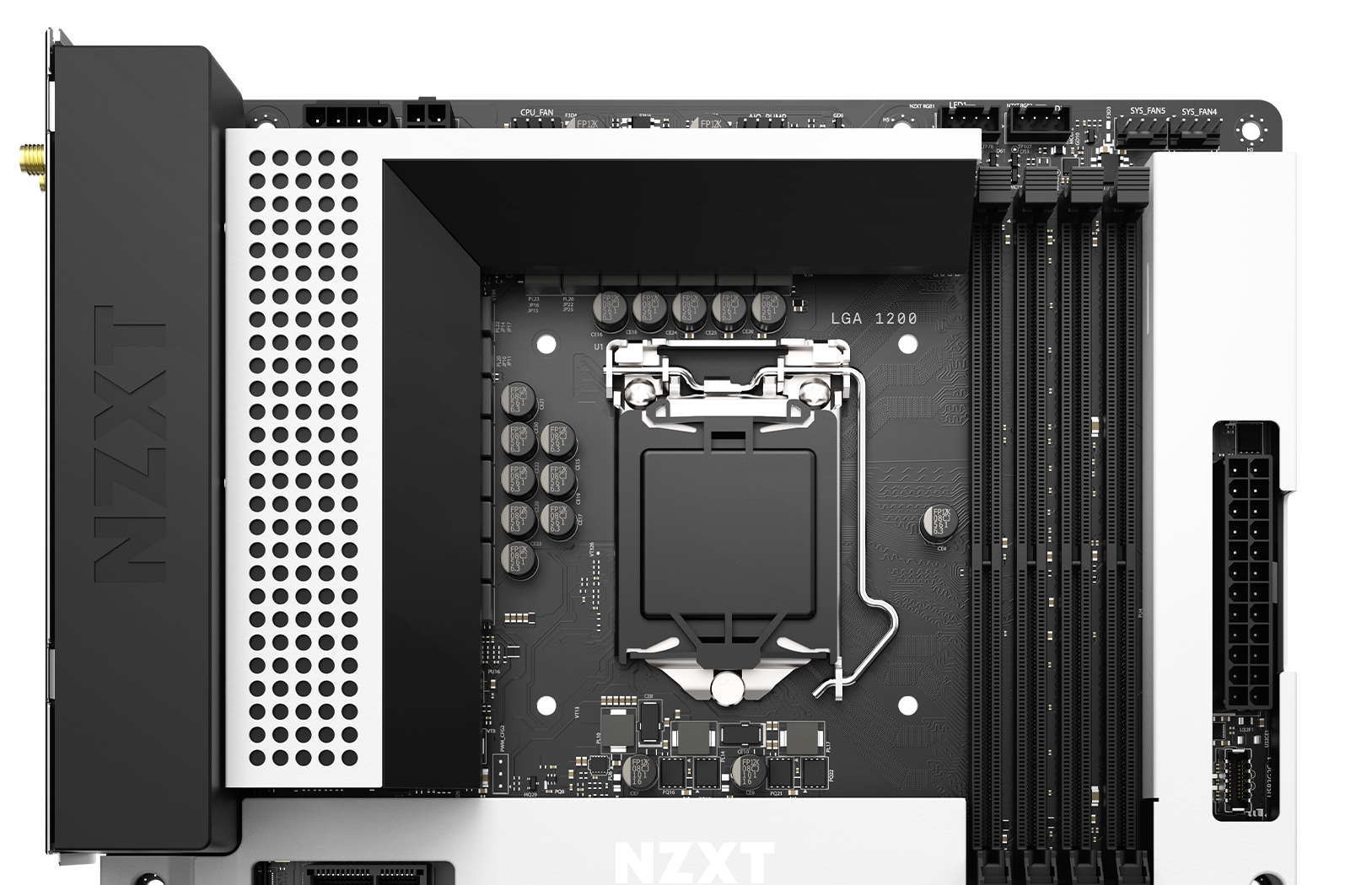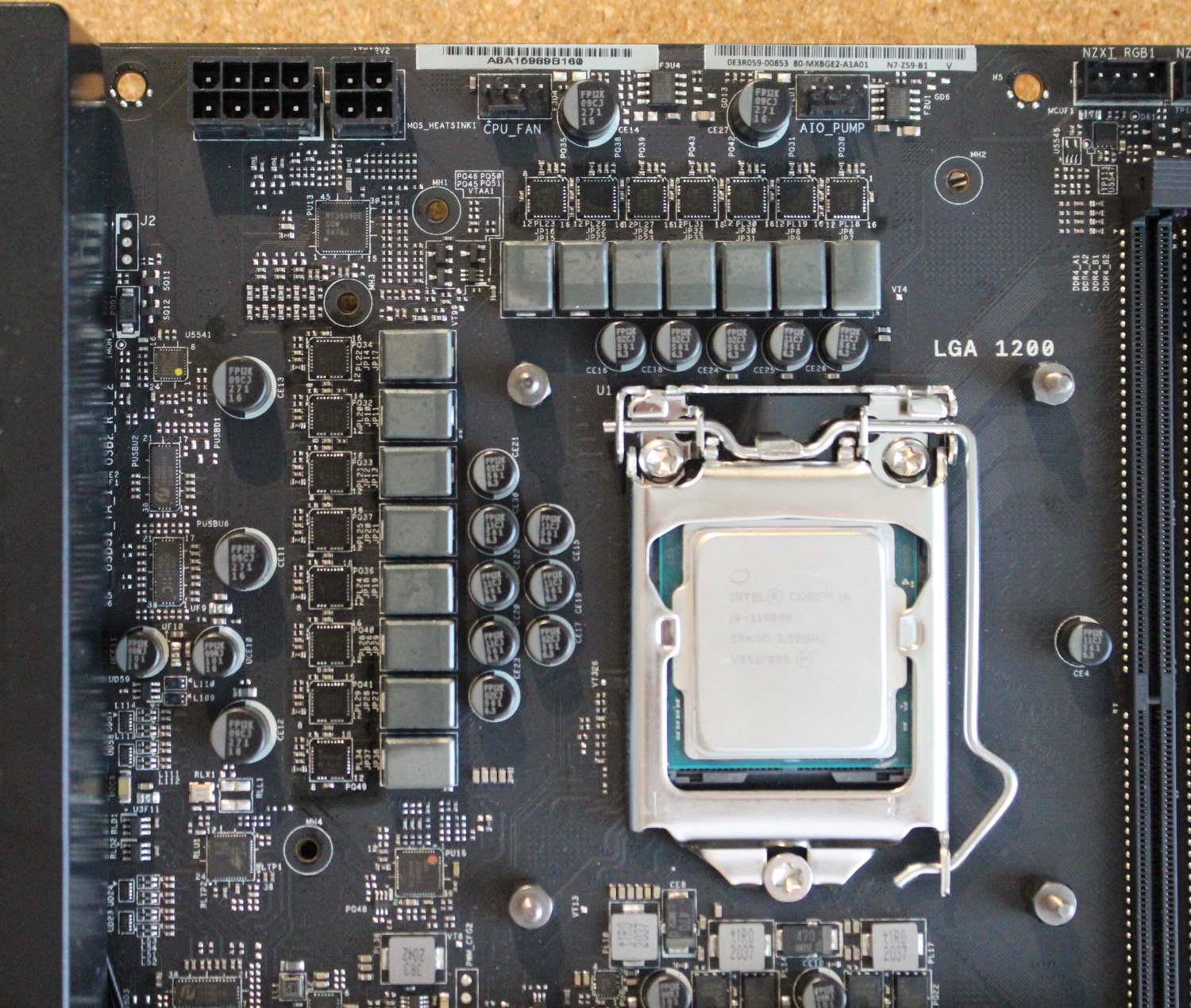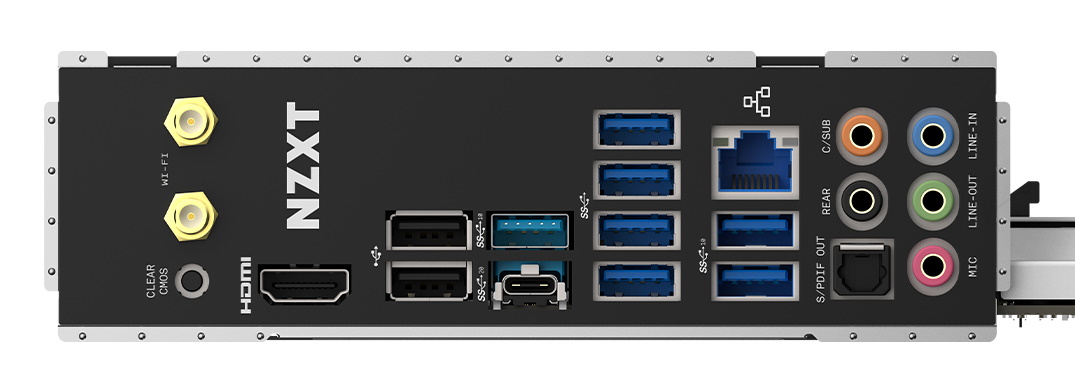Tom's Hardware Verdict
NZXT’s N7 Z590 is a full-featured Z590 motherboard that includes two M.2 sockets, Intel-based Wi-Fi 6E, capable power delivery, premium audio, and more. It’s a well-rounded mid-ranger for Intel’s Z590 platform, though for a similar price, there are other options with more and better parts.
Pros
- +
+ Wi-Fi 6E/2.5 GbE Networking
- +
+ Improved and capable power delivery
Cons
- -
Last-gen audio codec
- -
Only two M.2 sockets and four SATA ports
Why you can trust Tom's Hardware
NZXT has joined the Intel Rocket Lake motherboard party with the N7 Z590, bringing PCIe 4.0 capability (with a Rocket Lake CPU), capable power delivery, Intel Wi-Fi 6E, and a unique design aesthetic that easily matches most themes. With an MSRP of $279.99, the N7 positions itself as a strong competitor in the mid-range Z590 space.
NZXT worked with ASRock to bring you this board which appears to be based on the ASRock Z590 Steel Legend. We reviewed that board a couple of months back, and overall liked what ASRock offered at the price point. The N7 Z590, like previous NZXT motherboards, employs unique-looking shrouds/heatsinks that cover most of the board, giving it that signature NZXT appearance.
Performance-wise, the N7 Z590 did well overall. Its results traded punches with the other boards in most tests. Like the Steel Legend it’s modeled from, this board follows Intel specifications, and in a couple of tests (Handbrake, Cinebench/POV-Ray single thread), the times/scores were lower than the others. To bypass that, simply adjust the power limits up, as the other boards do from the factory. The N7 board set our DDR4 3600 sticks at 1:1 with the memory controller, and we saw solid results in our memory bandwidth and latency tests. Overclocking was a breeze too, as we set our CPU to 5.1 GHz while running the memory at DDR4 4000 (with a few tweaks for stability).
Although you can’t tell the difference by looking at the board, the Z590 version of NZXT’s board strives to improve upon the last generation and does so with aplomb. The N7 Z590 includes PCIe 4.0 M.2 socket (two total sockets, the other is PCIe 3.0) and a PCIe 4.0 x16 slot, additional USB ports including a USB 3.2 Gen2x2 Type-C on the rear panel, improved power delivery, and more. We’ll cover these features in detail and more below. But first, here are the full specs from NZXT.
Specifications - NZXT N7 Z590
| Socket | LGA 1200 |
|---|---|
| Chipset | Z590 |
| Form Factor | ATX |
| Voltage Regulator | 12 Phase (12+2, 50A MOSFETs) |
| Video Ports | (1) HDMI (v2.0) |
| USB Ports | (1) USB 3.2 Gen 2, Type-C (10 Gbps) |
| (3) USB 3.2 Gen 2, Type-A (10 Gbps) | |
| (4) USB 3.2 Gen 1, Type-A (10 Gbps) | |
| (2) USB 2.0 (480 Mbps) | |
| Network Jacks | (1) 2.5 GbE |
| Audio Jacks | (5) Analog + SPDIF |
| Legacy Ports/Jacks | ✗ |
| Other Ports/Jack | ✗ |
| PCIe x16 | (1) v4.0 x16 |
| (1) v3.0 x4 | |
| PCIe x8 | ✗ |
| PCIe x4 | ✗ |
| PCIe x1 | (2) v3.0 x1 |
| CrossFire/SLI | AMD CrossFireX |
| DIMM slots | (4) DDR4 4600(OC), 128GB Capacity |
| M.2 slots | (1) PCIe 4.0 x4 / PCIe (up to 80mm) |
| (1) PCIe 3.0 x4 / PCIe and SATA (up to 80mm) | |
| U.2 Ports | ✗ |
| SATA Ports | (4) SATA3 6 Gbps |
| Supports RAID 0, 1, 5 and 10 | |
| USB Headers | (1) USB v3.2 Gen 2 (Front Panel Type-C) |
| (2) USB v3.2 Gen 1 | |
| (2) USB v2.0 | |
| Fan/Pump Headers | (7) 4-Pin |
| RGB Headers | (2) NZXT RGB |
| (1) ARGB (3-pin) | |
| (1) RGB (4-pin) | |
| Legacy Interfaces | ✗ |
| Other Interfaces | FP-Audio, TPM |
| Diagnostics Panel | Q-LED |
| Internal Button/Switch | Power and Reset buttons |
| SATA Controllers | ✗ |
| Ethernet Controller(s) | (1) RealtekRTL8125BG (2.5 GbE) |
| Wi-Fi / Bluetooth | (1) Intel AX210 (WiFi 6, 2x2 160 Hz/6 GHz, MU-MIMO, OFDMA, BT 5.2) |
| USB Controllers | ASMedia ASM1074 |
| HD Audio Codec | Realtek ALC1220 |
| DDL/DTS Connect | ✗ / ✗ |
| Warranty | 3 Years |
Inside the box included with the motherboard are a few accessories. Our review board didn’t even have a driver disk (perhaps because this is a pre-launch sample), but what’s inside should allow you to get going without an extra trip to the store. For drivers, if a disk isn’t included in the retail packaging, you can get them from the NZXT website. Below is a complete list of the included parts.
- Motherboard Guide
- Wi-Fi Antenna
- (4) SATA cables
- (2) Screw package for M.2 sockets
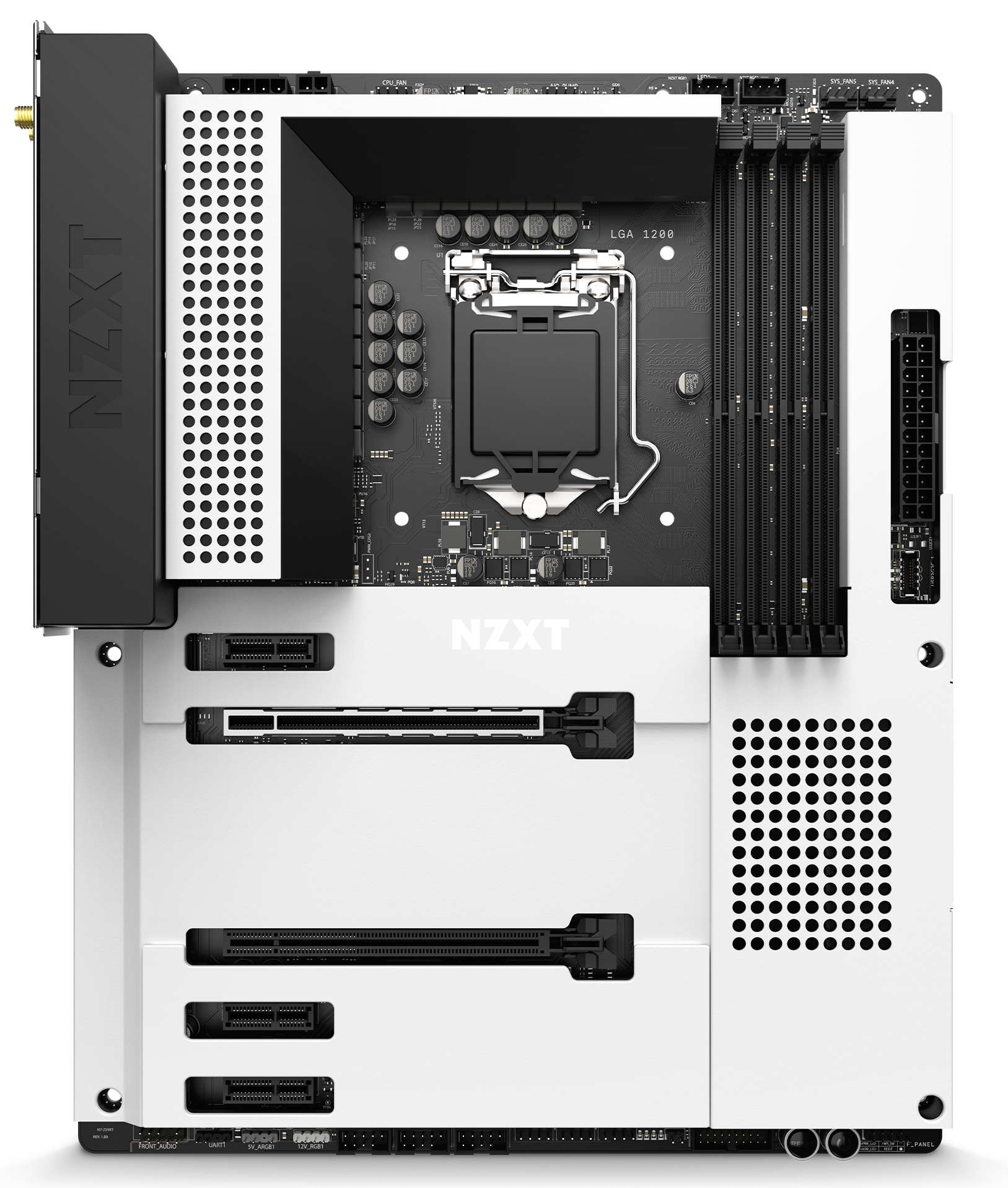
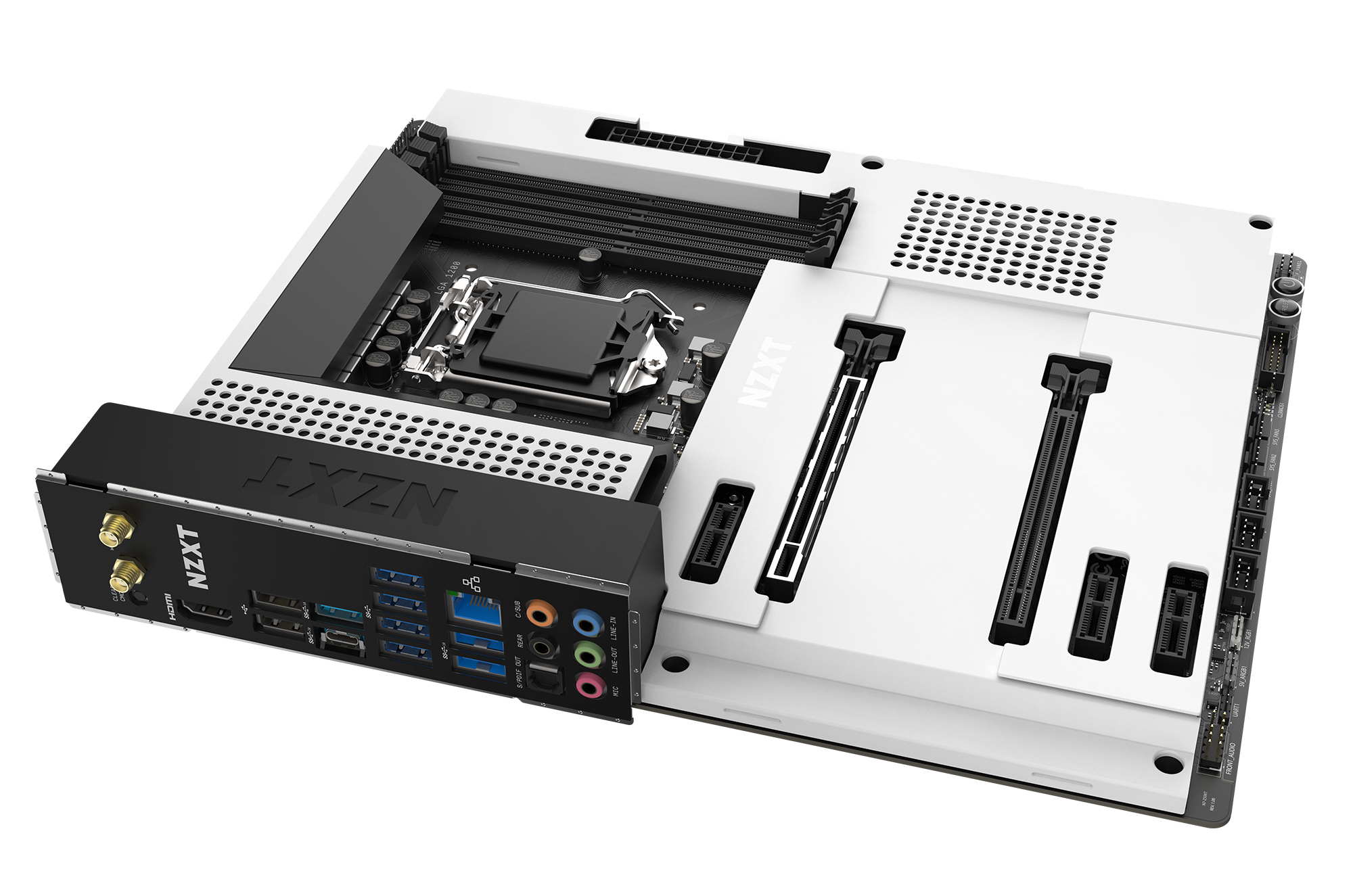

After taking the board out of the box, we get a chance to see the nearly completely covered 6-layer matte-black PCB. Just about the only design cues are the punched-out circles above the chipset and left VRM bank heatsinks. Additionally, some NZXT branding resides on the top M.2 socket cover and over the rear IO area.
If you’re looking for integrated RGB lighting, you’ll have to look somewhere else, as the N7 Z590 doesn’t include any. That said, the board has two RGB headers, a 3-pin ARGB and 4-pin RGB, along with two NZXT RGB LED connectors. The NZXT CAM software handles all RGB lighting control. Overall, I like how this board looks. The mostly covered PCB gives the board a premium look and feel that matches most any build theme. If a stealthy all-black motherboard isn’t your thing, the N7 Z590 also comes in white.
Get Tom's Hardware's best news and in-depth reviews, straight to your inbox.
Looking at the top half of the board, there isn’t much to see outside of shrouds. On the left, the IO cover reaches out over the rear IO chips and touches the left VRM bank. The heatsink doesn’t have a lot of surface area. but does an excellent job keeping the power bits cool, even while overclocked as we’ll see later.
Above the heatsink on the top edge, we find the 8-pin EPS (required) and a 4-pin EPS connector (optional) to feed power to the CPU. To the right are two (of seven) 4-pin fan headers. Each fan/pump header on the board is capable of 2A/24W output, as well as auto-detecting what type of fan is connected (PWM or DC). Continuing right are two 4-pin NZXT RGB headers and two more fan headers.
To the right of the socket area are four unreinforced DRAM slots that support up to 128GB of RAM. NZXT lists supported speeds up to DDR4 4600(OC). This is on the lower side compared to other boards, but most users will run RAM well under that speed. Our DDR4 4000 kit worked with a minor voltage change to the VccIO Memory voltage (0.10+), so we know it’s good to at least that point. Much beyond that and you pay a steep premium for little in the way of gains anyway.
On the right edge of the board, the only thing visible from the top is the 24-pin ATX for board power and a USB 3.2 Gen 2 Type-C front-panel port.
NZXT lists the N7 Z590 as a 12-phase Dr.MOS VRM, which breaks down to a 12+2 configuration for the Vcore and SOC. A Richtek RT3609BE (X+Y=8) 8-channel controller handles the CPU while a Renesas RAA229001 controls the SOC. The eight-channel controller feeds 12 Vishay Sic654 50A MOSFETs for CPU Vcore in a teamed/parallel configuration. In other words, NZXT does not use phase doublers on this board. This configuration is plenty for both 10th and 11th generation CPUs on this platform.
Focusing in on the bottom half of the board, we’re again greeted primarily by shrouds. Hidden underneath on the left-hand side is a Realtek ALC1220 codec, along with five audio caps and a Texas Instruments NE5532 OpAmp. While the ALC1220 codec is a solid audio solution (it was the flagship of Z490) most users are happy with, I would like to have seen the latest and greatest ALC4080/4082 here instead.
In the middle are a few PCIe slots and two M.2 sockets. Starting with PCIe, there are two full-length slots and three x1 size slots. The top slot is PCIe 4.0-capable with a Rocket Lake-based CPU, while the second full-length slot runs PCIe 3.0 x4 max and is fed from the chipset. The documentation doesn’t mention multi-GPU support. But by lane count, it should be able to run 2-Way CrossfireX. The three x1 slots are PCIe 3.0 and fed from the chipset as well. I like the x1 slot location, so you can easily insert an AIC without worrying about the location covering a full-length slot.
The top M.2 socket is located to the right of the top x1 slot. When using a Rocket Lake-based CPU, this socket runs at PCIe 4.0 x4 speeds and supports up to 80mm modules. The bottom M.2 socket runs at PCIe 3.0 and accepts SATA-based modules up to 80mm. The manual does not mention RAID functionality. Worth a mention is that although the M.2 covers are metal, they do not contact the M.2 modules to help with cooling. If you have hot-running M.2 modules, you may want to keep an eye out on temperatures.
As we move further to the right, we pass over the chipset heatsink on the way to the right edge. Here, hidden under the shroud with horizontally oriented connectors, we spy a USB 3.2 Gen 1 header and the four SATA ports. Although most users would be happy with four SATA ports and two M.2 sockets, this is less than most other boards at this price point. Many have three M.2 sockets and six SATA ports, all of which can be active (though not always) in specific configurations.
Across the board’s bottom are several headers, including more USB ports, fan headers and more. Below is the complete list, from left to right:
- Front-panel audio
- UART header
- RGB and ARGB headers
- (3) USB 2.0 header
- (3) System Fan headers
- Q-Code LEDs
- Clear CMOS jumper
- USB 3.2 Gen 1 connector
- Power/Reset buttons
- Front panel header
Flipping the board around to the rear IO area, we see the black pre-installed IO plate, which matches the colors and design of the rest of the board, along with the NZXT branding in white. In total, there are 10 USB ports: You get four USB 3.2 Gen 2 ports (3x Type-A, 2x Type-C), four USB 3.2 Gen 1 ports, and two USB 2.0 ports. A single HDMI port handles video output when using the integrated graphics on the CPU. You’ll also find the Wi-Fi antenna headers, a Clear CMOS button, the Realtek 2.5 GbE and the 5-plug plus SPDIF audio stack.
MORE: Best Motherboards
MORE: How To Choose A Motherboard
MORE: All Motherboard Content

Joe Shields is a staff writer at Tom’s Hardware. He reviews motherboards and PC components.
-
pixelpusher220 "You get four USB 3.2 Gen 2 ports (3x Type-A, 2x Type-C) "Reply
There is only 1 Type C and there are 3 Type A. The Specifications table has it correctly but the text of the article is wrong. -
Co BIY ReplyDookieDraws said:Looks may not matter to some, but that is one God awful ugly motherboard! 💩
The people who like to open the hood of their car and see a giant piece of plastic with one hole for windshield fluid will love this board.
I'm more neutral on it. Boring yes, but also clean looking. Do I need a MB cover inside a case ? Not really.
I think it's humorous that this board is based on the Steel Legend because that board has the design sense of a pachinko game. Added together and averaged out they are right down the middle.
-
jpe1701 You say that it has a unique style but it looks like all of nzxt's previous motherboards. I guess you meant unique as in different from the other current offerings from competitors, but they have been using almost the same look ever since they started selling motherboards and I think giving them credit for being unique is stretching it at this point.Reply -
Exploding PSU Man, that's one of the finest looking board I've ever seen. Very clean. Thinking of picking up their B550 one in my next upgradeReply
EDIT : after reading the comments I guess this is an unpopular opinion. Each to their own, right? -
jpe1701 Reply
It does look good, my gripe is it looks the same as all of their boards. But hey at least they are consistent. Lol.exploding_psu said:Man, that's one of the finest looking board I've ever seen. Very clean. Thinking of picking up their B550 one in my next upgrade
EDIT : after reading the comments I guess this is an unpopular opinion. Each to their own, right?
